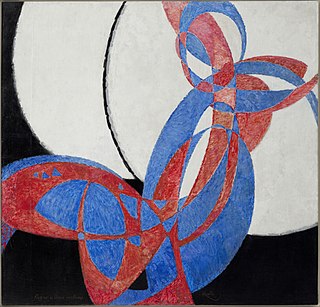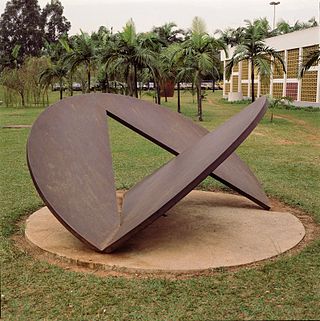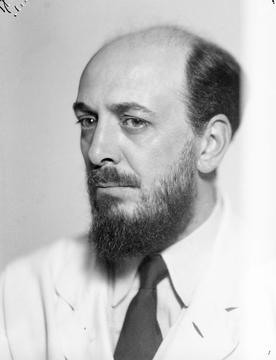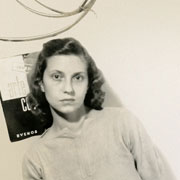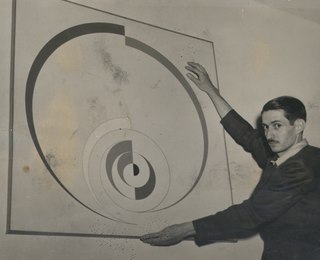We use the term “neo-concrete” to differentiate ourselves from those committed to non-figurative “geometric” art (neo-plasticism, constructivism, suprematism, Ulm School) and in particular the kind of concrete art that is influenced by a dangerously extreme rationalism. Compelled by their experiences, the painters, sculptors, engravers, and writers participating in this First Neo-concrete Exhibition came to the conclusion that it was necessary to revise the theoretical principles on which concrete art has been founded, none of which offers a rationale for the expressive potential they feel their art contains.
Born with cubism, as a reaction against the impressionist disintegration of poetic language, it was natural that so-called geometric art should situate itself in a position diametrically opposed to the technical and allusive resources of ordinary painting. The new achievements of physics and mechanics, in opening up a wide perspective for objective thought, encouraged, among those who continued this revolution, the tendency towards an everincreasing rationalization of the processes and purposes of painting. A mechanicalist notion of construction invaded the language of painters and sculptors, generating, in turn, equally extreme responses of a reactionary nature, such as magical or irrationalist realism, Dada, or surrealism. Therefore, there is no doubt that the true artists—as is the case with, for example, Mondrian or Pevsner—constructed their works following those theories that consecrated scientific objectivity and mechanical precision, but in that hand-to-hand combat with expression they overcame the limits imposed by theory. Yet the work of those artists has been interpreted to this day from theoretical positions that that same work denied. We propose a reinterpretation of neo-plasticism, constructivism, and other similar movements, basing ourselves on their expressive successes and making the work of art take precedence over theory. If we were to attempt to understand Mondrian’s painting starting from his theories, we would be forced to choose one over the other. We either find the prophecy of the complete integration of art in daily life to be possible (and we see in Mondrian’s work the first steps in that direction), or we view that integration as ever more remote, in which case his work seems to have failed. Either the vertical and the horizontal are truly the fundamental rhythms of the universe, and Mondrian’s oeuvre is the application of that universal principle, or the principle fails, and his work turns out to be based on an illusion. But the truth is that Mondrian’s work is there, alive and fertile, above these theoretical contradictions. It is useless to view Mondrian as the destroyer of the surface, of the plane and the line, if we do not perceive the new space that that destruction constructed.
The same can be said of Vantongerloo or Pevsner. It does not matter what mathematical equations are at the root of a sculpture or a painting by Vantongerloo, because only in the experience of its direct perception does the work provide the “meaning” of its rhythms and colors. Whether Pevsner started from figures of descriptive geometry or not is irrelevant, when one confronts the new space that his sculptures generate and the cosmic-organic expression that, through it, its forms reveal. Determining the ways in which artistic objects and scientific instruments, or the artist’s intuition and the physicist’s and engineer’s objective thought, converged may be interesting from a cultural standpoint, but from an aesthetic standpoint, the work of art provokes interest precisely because of what it possesses that transcends these external circumstances—because of the universe of existential meanings that merge and are revealed in the work of art.
Malevich, having recognized the superiority of “pure perception in art,” placed his theoretical definitions in a position that was safe from the limitations of rationalism and mechanicalism, projecting a transcendent dimension in his paintings that guarantees him a notable relevance today. But Malevich’s daring cost him dearly, in simultaneously opposing both figurative art and mechanicalist abstraction, for to this day certain rationalist theoreticians consider him a naïf who did not understand the true sense of the new plastic arts … In fact, Malevich already expressed, within “geometric” painting, his dissatisfaction, his desire to transcend the rational and the sensorial, which today is undeniably manifest.
Neo-concretism, emerging out of the need to express the complex reality of modern man with the structural language of the new plastic arts, denies the validity of the attitudes espoused by scientificism and positivism in art and reconsiders the problem of expression, incorporating the new “verbal” dimensions created by constructive, non-figurative art. Rationalism divests art of all autonomy and substitutes the untransferable qualities of the work of art with notions of scientific objectivity. Thus, the concepts of form, space, time, and structure—which in the arts are linked to an existential meaning, emotive and affective—are confused with their theoretical application by science. In fact, in the name of preconceived ideas that today’s philosophy denounces (M. Merleau-Ponty, E. Cassirer, S. Langer)—and that are collapsing in every field, starting with modern biology, which has overcome Pavlovian mechanicalism—the concretist-rationalists still view man as a machine among machines and attempt to limit art to the expression of that theoretical reality.
We do not conceive of art either as a “machine” or as an “object” but as a quasi-corpus, that is, an entity whose reality is not exhausted in the external relationships of its elements; an entity that, though analytically divisible into its parts, only gives itself up fully to a direct, phenomenological approach. We believe that the work of art overcomes the material mechanism upon which it rests, not due to some virtue lying outside this Earth: it overcomes it by transcending those mechanical relationships (which is the object of Gestalt theory) and by creating for itself a tacit signification (Merleau-Ponty) that emerges in it for the first time. If we had to search for a simile for the work of art, we could not find it, therefore, either in a machine or in objects taken objectively, but rather, as S. Langer and V. Wleidlé [sic] argue, in living organisms. Furthermore, this comparison would not be sufficient to express the specific reality of the aesthetic organism.
Since the work of art is not limited to occupying a place in objective space—but rather transcends it in basing a new signification in it—the objective notions of time, space, form, structure, color, etc. are not sufficient to understand the work of art, to fully explain its “reality.” The lack of an adequate terminology for expressing a world that does not succumb to notions led art critics indiscriminately to employ words that are unfaithful to the complexity of the created work. The influence of technology and science was manifest here as well, to the degree that today, with their roles reversed, certain artists, confused by that terminology, attempt to make art starting from these objective notions in order to apply them as a creative method. Inevitably, the artists who work in this fashion only reveal a priori notions, since they are constrained by a method that already prescribes the results of their work before they begin. By avoiding intuitive creation, by reducing himself to an objective body in an objective space, with his paintings the rationalist concrete artist hardly demands, from himself and from the viewer, a stimulating and reflexive reaction. He speaks to the eye as an instrument and not to the eye as a human means of possessing the world and of giving oneself to it; he speaks to the machine-eye and not the body-eye.
Given that the work of art transcends mechanical space, the notions of cause and effect lose all validity in it, and the notions of time, space, form, and color are integrated in such a way—since they lacked any existence, as those notions, prior to the work—that it would be impossible to speak of them as elements that can be broken down. Neo-concrete art, affirming the absolute integration of these elements, vouches for the ability of its “geometric” vocabulary to assume the expression of complex human realities, manifest in many works by Mondrian, Malevich, Pevsner, Gabo, Sofia Taeuber-Arp, etc. If even these artists at times confused the concept of mechanical form with expressive form, it is important to clarify that, in the language of art, these so-called geometric forms lose the objective character of geometry in order to become vehicles for the imagination. Gestalt theory, in that it is still a psychology based on the concept of causation, also proves insufficient in helping us understand that phenomenon that dissolves the causally definable realities of space and form and presents them as time, as the spatialization of the work. By “spatialization of the work” is meant the fact that it is continually making itself present, it is always regaining the impulse that generated it and of which it was, in turn, the origin. And if this description remits us likewise to the first—full—experience of the real, that is because neo-concrete art seeks nothing more than to revive that experience. Neo-concrete art creates a new expressive space.
This position is equally valid for neo-concrete poetry, which condemns in concrete poetry the same mechanicalist objectivism of painting. The rationalist concrete poets also established the imitation of the machine as an ideal for their art. For them, too, space and time are but external relationships between object-words. Now, if that is the case, the page is reduced to a graphic space and the word to an element of that space. As in painting, the visual here is reduced to the optical, and the poem does not transcend the graphic dimension. Neo-concrete poetry rejects such spurious notions and, faithful to the very nature of language, reaffirms the poem as a temporal entity. In time and space, the word unfolds its complex signifying nature. The page in neo-concrete poetry is the spatialization of verbal time: it is pause, silence, time. It is evidently not a matter of returning to the concept of time that characterizes discursive poetry; for while language flows in succession in discursive poetry, in concrete poetry language opens up in duration. Therefore, unlike rationalist concretism, which views the word as object and transforms it into a mere optical signal, neo-concrete poetry restores it to its condition as “verbum,” that is, to the human mode of presentation of the real. In neo-concrete poetry, language does not slip away, but rather remains.
In its turn, neo-concrete prose, opening up a new field for expressive experiments, recovers language as flux, overcoming its syntactical contingencies and giving new, fuller meaning to certain solutions that until now were erroneously accepted as poetry. This is how, in painting as in poetry, in prose as in sculpture and printmaking, neo-concrete art reaffirms the independence of artistic creation in the face of objective knowledge (science) and practical knowledge (ethics, politics, industry, etc.).
The participants in this First Neo-concrete Exhibition do not constitute a “group.” They are not united by dogmatic principles. The evident affinity of their explorations in various fields has brought them together and led them to meet here. The commitment that obliges them commits each one of them, first and foremost, to their individual experience; they will remain together as long as the deep affinity that brought them together endures.
 Wikidata () – Exhibition catalog of Cold America, Geometric Abstraction in Latin America (1934–1973), Fundación Juan March, Madrid, February 11-May 15, 2011
Wikidata () – Exhibition catalog of Cold America, Geometric Abstraction in Latin America (1934–1973), Fundación Juan March, Madrid, February 11-May 15, 2011 Wikidata () – Folleto de la expoción celebrada América fría. La abstracción geométrica en Latinoamerica (1934–1973) en la Fundación Juan March en Madrid del 11 de febrero al 15 de mayo de 2011
Wikidata () – Folleto de la expoción celebrada América fría. La abstracción geométrica en Latinoamerica (1934–1973) en la Fundación Juan March en Madrid del 11 de febrero al 15 de mayo de 2011
